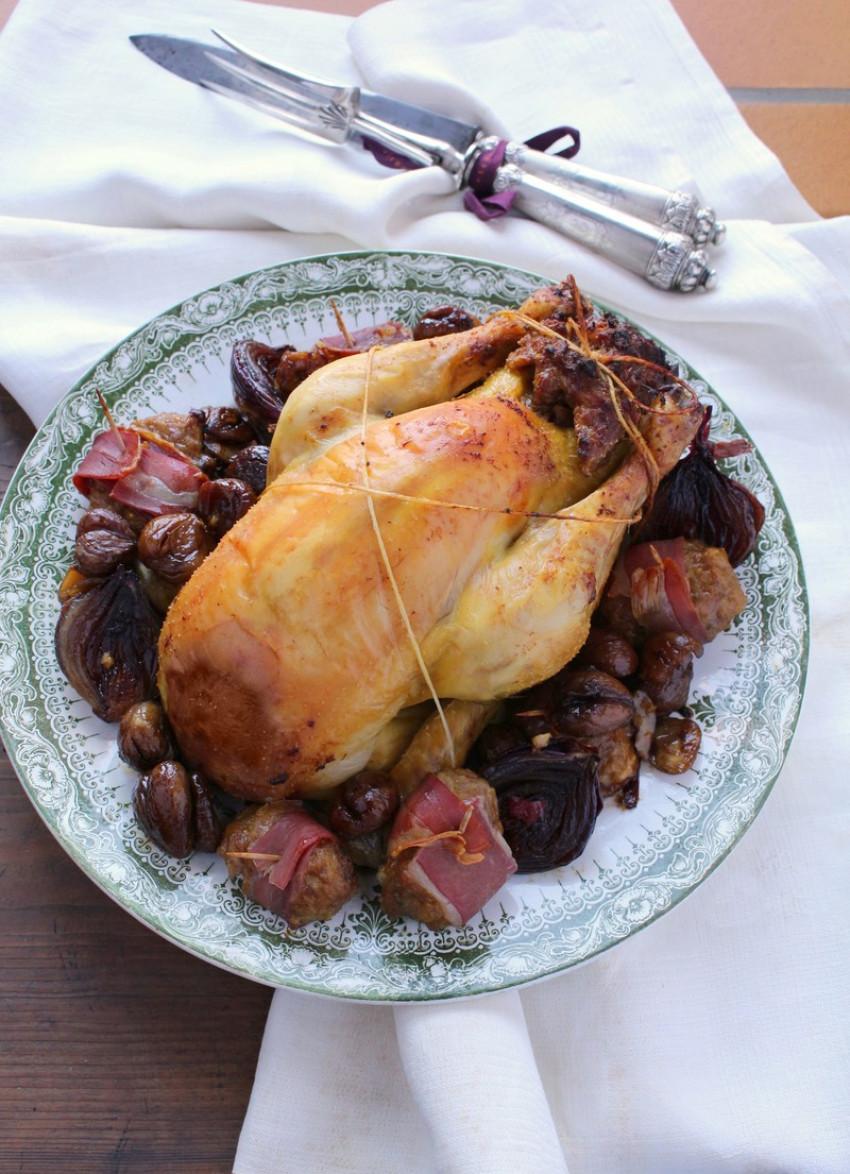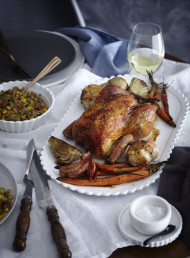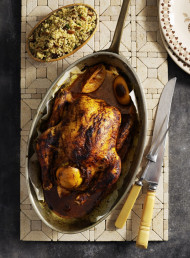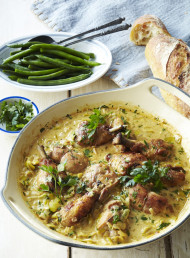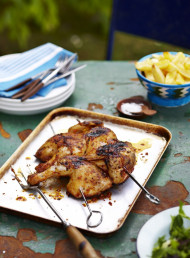Roast Spiced Chicken with Pain d'Epice
Photography by Rachael Hale McKenna .
Allyson Gofton's latest cookbook 'Recipes from my French Kitchen' documents her experiences of uprooting a family of four to rural France, alongside recipes inspired by the local culture, like this warming roast chicken dish.
INGREDIENTS
¼ cup milk
2 tablespoons Armagnac or brandy
100–150 grams Pain d’Épice, crumbed (recipe follows)
1 onion, peeled and finely diced (use a white onion if you have one)
2–3 cloves garlic, crushed, peeled and mashed to a paste with salt
100 grams butter
500 grams pork mince (it must be coarsely ground)
8–10 whole chestnuts, bottled or canned, chopped into pea-size pieces
1 egg
1 large chicken for roasting (remove any bits remaining inside)
At the market each week we were able to buy wonderful fresh poulets fermiers – chickens direct from the farmer. Their golden skin and sweet flesh is a result of a diet of locally grown maize. I would regularly see beret-wearing farmers driving through Caixon with a deep-sided trailer hitched to the back of their rusty, smoke-belching tractors, full to overflowing with maize, en route to home to fatten up the chickens, ducks or livestock. Often they would stop at the crossroads outside our maison (house) and chat to their mate coming the other way; no hurry, no pressure. I loved this scene, it was like watching a real-live 1950s movie. Serve this delicious spiced chicken with halved roasted onions and extra chestnuts, or with roasted red onions or shallots.
METHOD
Prep time: 30 minutes
Cooking time: about 2 hours
Serves: 6–7
Preheat the oven to 180°C.
Sprinkle the milk and Armagnac or brandy over the Pain d’Épice. Cook the onion and garlic in a knob of the butter until soft. Cool. Mix together the Pain d’Épice, onion mixture, pork mince, chestnuts and egg. Season.
Stuff the chicken cavity with the pork mixture. Tie the legs together loosely and sit the chicken in a roasting dish. Spread the remaining butter on top of the chicken. Any leftover stuffing can be rolled into balls, wrapped in bacon rashers or jambon and added to the roasting dish in the last hour of cooking. Add halved onions and extra chestnuts too, if wished.
Roast in the preheated oven for around 2 hours or until the chicken is cooked. Use any fat and juices remaining in the dish to make gravy, if wished.
Pain d’Épice
Honey and spice cakes – of some description – are classically European; almost every country will have a version baked specially for the holy season. Both were once the domain of monks, who tended hives at their monasteries and utilised the therapeutic properties of spices, which were so extravagantly expensive they were only for the men of God or the wealthy. Thus monasteries became famous for creating these long keeping, once-a-year celebration cakes or breads.
A good Pain d’Épice needs time; like good wine, its making cannot be rushed. The batter must rest overnight before cooking; and afterwards the honey will only be able to weave its magic, creating a moist, mellow spiced cake, if allowed time to do so: a week or two, well wrapped in a cool place, is a must. Pain d’Épice was on sale everywhere in the weeks preceding Christmas and at varying prices, but I decided to have a crack at making my own for our first Christmas.
Prep time: 30 minutes
Standing time: overnight
Cooking time: 1½–2 hours
Makes: 1 large loaf
1½ cups whole milk
1 cup brown sugar (I prefer a mix of soft brown and muscovado; molasses is too strong)
500 grams honey (choose one with a robust flavour)
500 grams flour (if you can, use high-grade flour)
1 tablespoon Pain d’Épice spice mix*
1½ teaspoons baking soda (for a lighter pain use 2 teaspoons)
1 egg, beaten
In a saucepan, gently heat the milk and sugar over a low heat, stirring without boiling, until the sugar has dissolved. Remove from the heat and stir in the honey. If the milk boils, it will curdle; if this happens, don’t fret – it will look messy but can still be used, although the finished texture may be denser.
Sift the flour and spice mix together in a bowl and make a well in the centre. Gradually pour in the milk and honey mixture, stirring until the batter is smooth. I like to use a sturdy large balloon whisk to do this, but a good old wooden spoon is just fine, although do make sure you have no lumps of flour. Cover and refrigerate overnight. This step is extremely important as it allows the starch granules in the flour to expand, which is essential in ensuring a moist, tender bread.
Preheat the oven to 120°C and set the rack just below the centre. Grease and line a large (26cm x 11cm or 8½–9-cup capacity) loaf tin. Alternatively, grease 16 x ½-cup capacity mini cake moulds.
Dissolve the baking soda in 1 tablespoon warm water and stir into the batter with the beaten egg. Pour into the prepared tin and cover with baking paper. If using moulds, place these on a baking tray – there is no need to cover them, as their cooking time will be much shorter.
Bake in the preheated oven for 45 minutes. Remove the paper and continue to cook for a further 1 hour or until a cake skewer inserted in the middle comes out clean. Small cakes will take about 1 hour.
Leave the bread to cool in the tin for 15 minutes, then turn out. Do not try to turn out the Pain d’Épice while it is still hot, as it will break into large pieces. When cold, wrap well in foil, leaving the lining paper on. Store in an airtight place for 1 week before venturing to slice. Any earlier and the flavour will not be mellow or the crumb moist. Best left for 2–3 weeks.
*There are as many versions of the spice for Pain d’Épice as there are shoe shops in France. I settled on the Albert Ménés brand, which uses cassia and mace. Cassia is the variety of cinnamon preferred in many European sweet breads and has a much more vibrant flavour, while mace will always offer more to a dish when partnered with nutmeg – just as nature intended.
Mix 2 tablespoons of ground ginger with 1 tablespoon each of ground cassia, cinnamon, cloves, nutmeg, mace and cardamom and ½ tablespoon ground aniseed (or use ground star anise). Keep in an airtight container away from heat and light. Use to make spice biscuits. In summer, I added a large pinch to peaches when poaching them – scrumptious

Meet Allyson Gofton
Hear Allyson speak while she’s on tour to the following centres: Nelson (28 April), Upper Hutt (28 April), Masterton (29 April), Feilding (30 April), Coastlands (30 April), Palmerston North (1 May), Whanganui (1 May), Waipawa (1 May), Taradale (2 May), Gisborne (2 May), Christchurch (6 May), Ashburton (7 May), Oamaru (7 May), Gore (8 May), Cromwell (8 May), Wanaka (9 May), Tauranga (14 May), Hamilton (14 May) & Rotorua (15 May).
For event details visit: www.penguin.co.nz/events
Recipe reproduced with permission from Recipes from my French Kitchenby Allyson Gofton. Published by Penguin. RRP $45.00. Copyright text, recipes and photographs © Allyson Gofton, 2015. Available nationwide.
Keep up to date with
dish weekly recipes,
food news, and events.
latest issue:
Issue #120
As the days become shorter, and the nights cooler, the latest issue is perfectly timed to deliver delicious autumn dishes. From recipes using fresh seasonal produce such as feijoas and apples, to spectacular soothing soups and super-quick after-work meals in our Food Fast section, we’ve got you covered. With Easter on the horizon, we feature recipes that will see you through breakfast, lunch and dinner over a leisurely weekend holiday, and whip up chocolatey baking treats sure to please. We round up delicious dinners for two and showcase a hot new Korean cookbook before heading south to Dunedin to check out all that’s new in food and dining.The latest issue of dish is on sale NOW at all good bookstores and supermarkets – don’t miss it!

